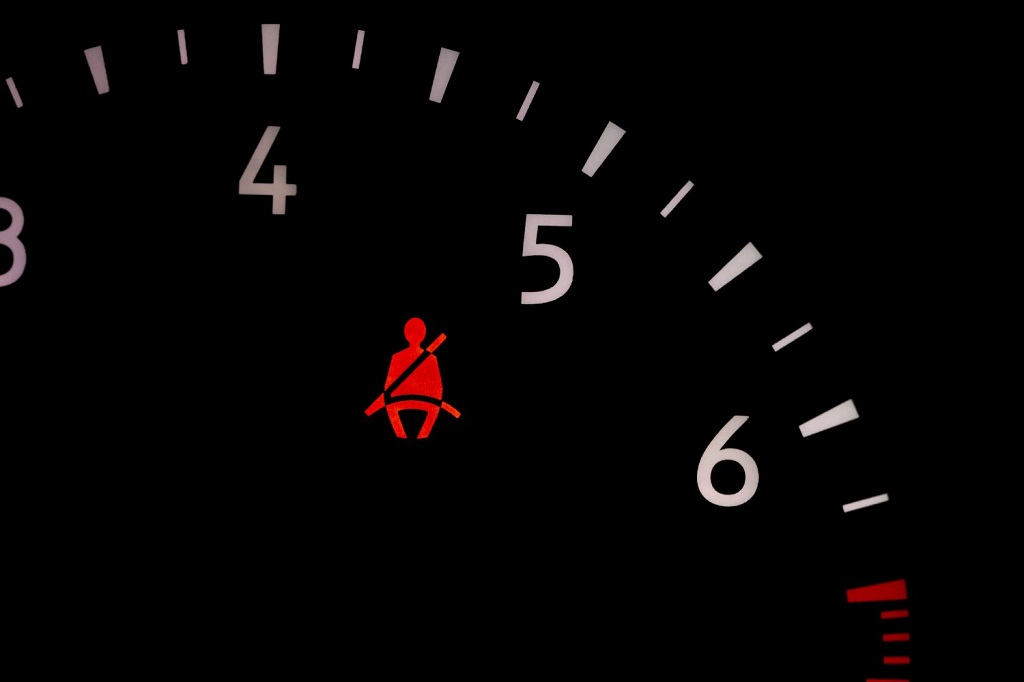Reasons Your Seat Belt Warning Light Stays On

Generally, your seat belt warning light should only turn on if you or a passenger haven’t securely fastened their seatbelt. It should then go off once you do.
However, sometimes this system fails to work properly. If your seat belt warning light stays on, the following reasons might explain why.
The Buckle Isn’t Fastened
A seat belt warning light stays on is usually the result of the seat belt buckle not being fastened. A properly secured seat belt should have a solid “click” sound when the metal tab is inserted into the buckle’s slot. If this does not happen, the sensor will detect no one in the seat and turn on the seat belt warning light.
Another possibility is that something is stuck inside the seat belt buckle itself. A small pebble or hairpin may have become lodged in the mechanism. To check this, use a screwdriver or something flat and pointy like a butter knife to poke around the entrance of the buckle. If you find anything, shoot some lubricant—WD-40 or Tri-Flow works well—into the clip to disperse whatever has gummed up the system.
Finally, if a passenger sits in the front seat, the occupancy sensor might signal that someone is in the middle when there isn’t. Ensure passengers are seated correctly, with their hips and back against the seatback and their shoulders touching the belt’s shoulder restraints (refer to your owner’s manual for specific instructions).
Sometimes, corrosion or damage within the electrical connections of the buckle switch can disrupt its ability to communicate with the vehicle’s computer system, leading to an open circuit and continuous seat belt warning light activation. It can be caused by impact or debris that’s gotten into the system, such as debris in a collision.
The Sensors Are Broken
The seat belt warning light will usually show up if you or a passenger in your car don’t have their seat belt fastened. A beeping sound will also accompany it until the seat belt is reconnected. Several things can trigger the seat belt warning light, including objects on the seat, sensor malfunctions, or even issues with the seat belt itself.
Your seat belt warning lights are based on electrical circuits that are closed or open when a certain condition is met. When you buckle up the seat belt, it closes the circuit. Similarly, the course opens again when you remove and open the belt. Sometimes, these sensors can break due to normal wear and tear or from crumbs of food falling into the buckle slot. The problem can be solved by spraying some electric contact cleaner on the connector under the seat.
If your seatbelt warning light stays on despite you or your passengers having their seatbelts fastened, it can be dangerous to drive your vehicle and should be fixed immediately. Driving without a seatbelt is illegal in most states and can lead to serious injury or death in an accident, so it’s important to resolve the issue as soon as possible. If you’re unsure what’s causing the problem, take your vehicle to an experienced mechanic who can identify and fix the issue.
The Sensors Are Overloaded
You must ensure your car’s safety features work properly as a driver. It includes the seat belt and occupancy sensors, which ensure your passengers are fastened safely. But when your car’s passenger seat belt light is on, it could mean the sensors are overloaded or faulty. It can be caused by cargo on the seat, a bad occupancy sensor, or a broken seat belt buckle. Luckily, there are some simple troubleshooting tips you can try before taking your car to a mechanic.
First, check the seat belt buckle to ensure it’s inserted correctly into its receptacle. It’s also possible that there’s a heavy object in the front seat, tricking the sensor into thinking a person is sitting there when there isn’t. Moving the load to a different center, the seat belt light should go off.
Additionally, it’s important to periodically inspect the seat belt webbing for signs of wear or damage. It will help prevent the passenger seat belt light from activating in the future and ensure optimal occupant safety. It’s also a good idea to clean the occupancy sensor and receptacle frequently with a cloth to keep them free of dirt and debris that could cause malfunctions in the future. These preventative measures can help you avoid costly repair costs in the long run.
The Wiring Is Damaged
Your seat belt system uses sensors and a computer to ensure you or your passengers are always safely fastened. Unfortunately, these components can be damaged over time by heat, water or wear and tear. If you have a broken sensor or sensor connection, the computer will detect that and turn on your airbag light. You’ll need to repair or replace the damaged component and reset the SRS computer to fix this.
If the passenger seat belt light stays on, your car detects a large amount of weight in the seat. It could be due to a heavy object in the back seat that is fooling the seat belt sensors into thinking someone is sitting there, or it could be because the passenger seat belt isn’t fastened.
The most common reason for the seat belt warning light to stay on is a problem with the seat belt buckle switch. This switch closes an electrical circuit when the seat belt is buckled. Over time, it can become worn out due to general wear and tear or failure if crumbs of food or other debris fall into the buckle slot. If you suspect this is the issue, you can try spraying some electric contact cleaner into the buckle and disconnecting and connecting it a few times to see if that fixes the problem.
